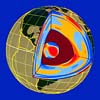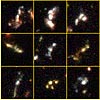| FEBRUARY 20, 2006 |
 |
our time will build eternity |
| LAST 5 DAYS | FEB 17 | FEB 16 | FEB 15 | FEB 14 | FEB 13 |
China Might Be Planning Early Space Station Attempt Melbourne, Australia (SPX) Feb 19, 2006
Melbourne, Australia (SPX) Feb 19, 2006If a picture paints a thousand words, then a few remarks about the future of the Shenzhou program can spawn a journalist to write more than a couple of thousand. That's going to be the rough total of the two commentaries I have now composed from dissecting the latest statements of Qi Faren, one of a handful of senior names publicly linked to the Shenzhou program. Universe Ablaze With X Rays From Giant Black Holes  St Louis MO (SPX) Feb 19, 2006
St Louis MO (SPX) Feb 19, 2006The universe contains hundreds of millions of super-massive black holes, many more than scientists previously had thought, and the monstrous objects occupying the centers of most galaxies seem to have evolved differently than expected. Giant Planet Cores May Contain 'Electric' Rocks  Minneapolis MI (SPX) Feb 20, 2006
Minneapolis MI (SPX) Feb 20, 2006Researchers said their computer simulation shows rocks that exist at temperatures and pressures likely to exist at the cores of Jupiter, Saturn and giant extrasolar planets exhibit electric conductivity. The researchers - Renata Wentzcovitch and Koichiro Umemoto at the University of Minnesota, and Philip B. Allen of Stony Brook University in New York - said the model creates rocks in these environments that are considerably different from those on Earth. |
Lunar Reconnaissance Orbiter Passes Preliminary Design Review Washington, DC (SPX) Feb 20, 2006
Washington, DC (SPX) Feb 20, 2006NASA's Lunar Reconnaissance Orbiter team said Friday it has completed its preliminary design review as part of the mission confirmation process. Massive Galaxies Formed Quickly In Early Universe  Surrey, UK (SPX) Feb 20, 2006
Surrey, UK (SPX) Feb 20, 2006British researchers said Sunday they have found the first observational evidence of how massive galaxies formed in the universe. The researchers said the results - which could have major implications for many other research areas - already are being used by astronomers to explain seemingly unrelated processes, such as how massive black holes and the universe's stars came to be. New Hypothesis Tackles Cosmic Ray Mystery  Boulder CO (SPX) Feb 20, 2006
Boulder CO (SPX) Feb 20, 2006Scientists said they have developed a new model to explain why a powerful type of cosmic radiation is largely absent from a location at the edge of the solar system that was thought to be its source. The area is called the termination shock, and the Voyager 1 spacecraft passed through the blunt nose of the region in December 2004 without detecting the phenomenon, called anomalous cosmic rays. |
Opportunity Rover Inspecting 'Bellemont' Pasadena CA (SPX) Feb 19, 2006
Pasadena CA (SPX) Feb 19, 2006Opportunity has completed its work on the "Olympia" outcrop. This week's activities included a Moessbauer spectrometer integration on target "Rough Rider," an alpha particle X-ray spectrometer integration on target "Fala," and a short drive to "Bellemont." Also the rover took microscopic imager mosaics of four targets at Bellemont. Search For Alien Life Challenges Current Concepts  Boulder CO (SPX) Feb 19, 2006
Boulder CO (SPX) Feb 19, 2006For scientists eying distant planets and solar systems for signs of alien activity, University of Colorado at Boulder Professor Carol Cleland suggests the first order of business is to keep an open mind. Space Adventures Plans Persian Gulf Spaceport  Arlington, VA (SPX) Feb 20, 2006
Arlington, VA (SPX) Feb 20, 2006Space Adventures Ltd. said Friday it plans to develop a commercial spaceport in Ras Al-Khaimah, one of the United Arab Emirates. The estimated cost of the project will be at least $265 million, the company said in a statement. Various parties will fund the project, including the Ras Al-Khaimah government and Space Adventures, which said it has received commitments of $30 million so far. |
Spirit Studies Layered Rocks Pasadena CA (SPX) Feb 19, 2006
Pasadena CA (SPX) Feb 19, 2006Spirit will soon be on top of the rugged plateau known as "Home Plate," which features the most spectacular layering Spirit has yet encountered, and begin taking images of the surrounding terrain. Spirit had a productive week investigating two rock targets, "Barnhill" and "Posey." Successful Venus Express Main Engine Test  Paris, France (SPX) Feb 19, 2006
Paris, France (SPX) Feb 19, 2006One hundred days after beginning its cruise to Venus, ESA's Venus Express spacecraft successfully tested its main engine for the first time in space. The main engine test is a critical step in the mission. In fact, it is due to its powerful thrust that Venus Express will be able to 'brake' on arrival at Venus. The Other, Unlifelike Earth  Ashburn VA (SPX) Feb 19, 2006
Ashburn VA (SPX) Feb 19, 2006Clues to finding current or past life on Mars now or at some point in the past begins with an examination of Earth's most extreme environments and the adaptable microscopic life that thrives there, according to a group of researchers launched an international broadcast science expedition January 30, 2006 with The JASON Project. |
|
| The contents herein, unless otherwise known to be pubic domain, are Copyright 1995-2005 - SpaceDaily. AFP and UPI Wire Stories are copyright Agence France-Presse and United Press International. ESA Portal Reports are copyright European Space Agency. All NASA sourced material is public domain. Additional copyrights may apply in whole or part to other bona fide parties. Advertising does not imply endorsement, agreement or approval of any opinions, statements or information provided by SpaceDaily on any web page published or hosted by SpaceDaily. Privacy statement |
| LAST 5 DAYS | FEB 17 | FEB 16 | FEB 15 | FEB 14 | FEB 13 |